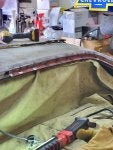I thought I'd share my experience replacing metal around my rear window using fresh sheet and new channel from www.rustreplace.com aka Belden Speed and Engineering. My '70 Nova is an original vinyl top car and things were getting bad.
First here are some before images after removing my rear glass and peeling back the vinyl top. I've circled all the holes using silver Sharpie.
![Image]()
![Image]()
![Image]()
![Image]()
![Image]()
I started by running a wire wheel over everything, which opened up new holes in thin areas I hadn't seen initially. I also poked around with a screw driver to find more bad spots before outlining areas I would need to patch. I also treated the whole area with Rust Kutter, a phosphoric acid rust converter. Like Ospho or Krud Cutter, this uses phosphoric acid to convert iron oxide (rust) into more stable iron phosphate. It left a white residue on everything which I will have to clean off before painting.
On the lower area, I decided to patch areas with cut pieces of sheet metal rather than replace the entire panel. I cut the rectangular pieces of 20awg sheet first then used a scribe to transfer the exact shape onto the old panel. Finally I cut it out with a combination of a body saw and a Dremel with a tiny cutoff wheel.
![Image]()
I used Eastwood stitch weld magnets to hold the patch pieces in place while I tack welded. These magnets are very strong and quite useful, but I found you have to be about an inch away from them otherwise they interfere with the weld and cause weird spattering.
![Image]()
![Image]()
A couple of these required bends like along the lower edge of this patch where the original bent area was rusted away. It's important to cut out all the margins of the rust otherwise the weld will just blow through. You can see there is also a small rust hole next to this patch which could be welded shut without a patch.
![Image]()
For the upper and side channels, I bought pre-fabricated pieces from www.rustreplace.com. These have already gone through a shrinker to get the curves, but they have to be trimmed to fit. This is what a couple of them look like prior to trimming.
![Image]()
First here are some before images after removing my rear glass and peeling back the vinyl top. I've circled all the holes using silver Sharpie.
I started by running a wire wheel over everything, which opened up new holes in thin areas I hadn't seen initially. I also poked around with a screw driver to find more bad spots before outlining areas I would need to patch. I also treated the whole area with Rust Kutter, a phosphoric acid rust converter. Like Ospho or Krud Cutter, this uses phosphoric acid to convert iron oxide (rust) into more stable iron phosphate. It left a white residue on everything which I will have to clean off before painting.
On the lower area, I decided to patch areas with cut pieces of sheet metal rather than replace the entire panel. I cut the rectangular pieces of 20awg sheet first then used a scribe to transfer the exact shape onto the old panel. Finally I cut it out with a combination of a body saw and a Dremel with a tiny cutoff wheel.
I used Eastwood stitch weld magnets to hold the patch pieces in place while I tack welded. These magnets are very strong and quite useful, but I found you have to be about an inch away from them otherwise they interfere with the weld and cause weird spattering.
A couple of these required bends like along the lower edge of this patch where the original bent area was rusted away. It's important to cut out all the margins of the rust otherwise the weld will just blow through. You can see there is also a small rust hole next to this patch which could be welded shut without a patch.
For the upper and side channels, I bought pre-fabricated pieces from www.rustreplace.com. These have already gone through a shrinker to get the curves, but they have to be trimmed to fit. This is what a couple of them look like prior to trimming.






